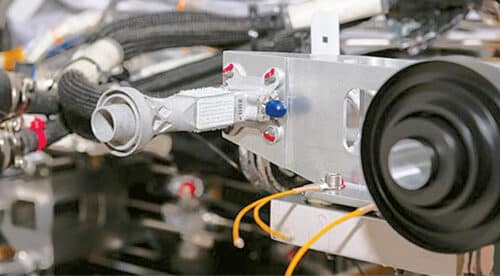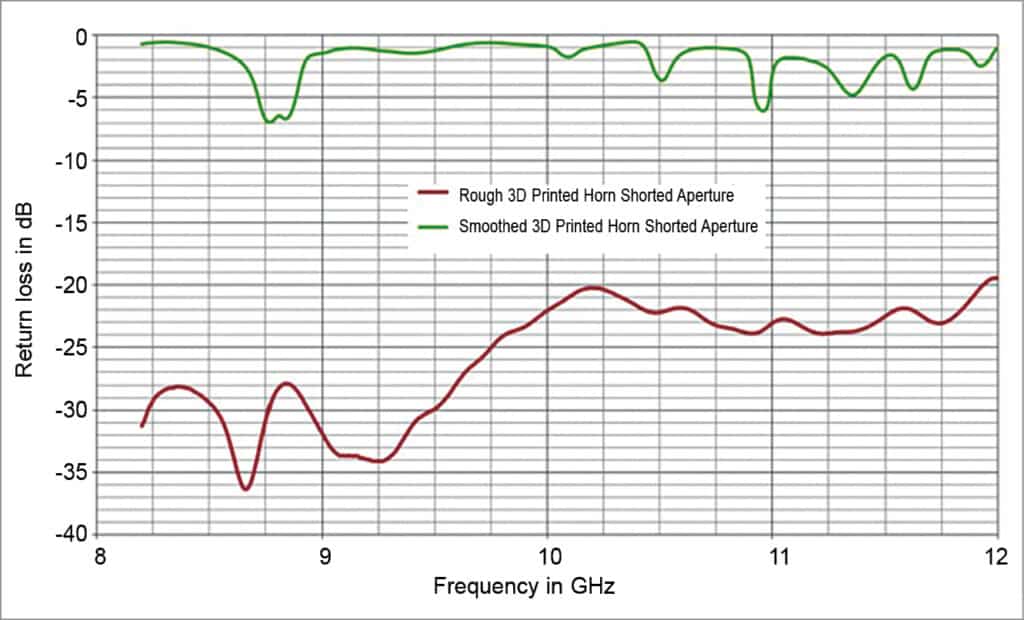Metal 3D printing can be used in a wide variety of industries including automotive, electronics, space, and defence. The use of metal 3D printing in designing antennas can change how we design and manufacture antennas for communication applications.
3D printing is an additive manufacturing process that prints 3-dimensional objects by printing stacks of 2D layers repeatedly until a desired 3D object is formed. 3D metal printing uses metal as a feedstock to create intricate objects that are not possible by any existing technique.
Different metals and alloys can be used as printing materials. 3D metal can become useful in many industries, including electronics, communication, automotive, medical, etc. It holds the potential to enhance the electronics industry in many ways.
In this article, we will see the most common types of metal 3D printing techniques, their advantages, and how metal 3D printing can improve RF communication.
Types of 3D printing in metal
Metal 3D printing can be distinguished by the nature of melting process and by the type of feedstock it uses. The most common type of metal 3D printer uses metal powder or a metal wire. And this printer uses various techniques to fuse the metal together. Some of the most common types of metal 3D printing techniques are:
Metal powder bed fusion
Powder bed fusion, also known as powder bed melting, is the most used method for 3D metal printing. In this method a hopper uniformly distributes a fine layer of metal powder over the build plate and the powder is melted using an energy beam in a desired shape to form a cross-sectional layer.

The hopper re-applies the metal powder and the process is repeated over and over again. The thickness of metal powder is commonly between 25µm and 100µm, but the optimal thickness of each layer of spread powder depends on the processing conditions and material used. There are two types of powder bed fusion technique:

Electron beam melting (EBM)
EBM is a type of metal-powder bed fusion technique where an electron beam is used for melting the metal powder. It requires higher energy compared to the other (SLM) method described below. The process takes place in a vacuumed environment. This method requires less tooling and setup cost. One of the main drawbacks of this method is that the surface finish of the printed product is poor and is similar to that of the sand casting technique.
Selective laser melting (SLM)
SLM is also a type of metal-powder bed fusion technique where a laser is used for sintering the metal powder. This method is capable of working with nearly all alloys. Furthermore, the mechanical properties of the printed parts are equal to conventionally formed parts. But this technique is relatively slow and requires expertise to achieve quality print. Also, expensive post-processing is required before printed objects are ready for use.
Direct energy deposition (DED)
Direct energy deposition is a technique of metal 3D printing which uses a metal feedstock either in the form of a metal powder or wire and a heat source, such as a laser beam, to fabricate parts. The laser and the feedstock sit on a single print head. The method can be divided on the basis of feedstock as:
Wire DED
Wire-directed energy deposition is a technique where a metal wire is used as a feedstock in place of metal powder. A heat source—such as an electric arc, laser, or electron beam—is used as the energy source to continuously melt and deposit the metal wire along a predetermined path. The wire DED is simpler and cheaper than power based metal 3D printing. It also has a high deposition rate, which makes the process faster. When compared to metal powder, the wire as a feedstock enables higher quality prints and higher overall safety along with lower print cost.
Bound powder extrusion (BPE)
BPE is one of the newer techniques where the feedstock is a metal powder bound together with a waxy polymer. This makes the technique much safer than one with loose powder. The BPE filament is extruded out of a nozzle into the desired shape. After printing, the object has to go through two more steps, which include washing out and sintering the 3D object. The washing removes any traces of wax polymer and the sintering allows the part to shrink and fill any spaces opened up by the dissolved binder, thus yielding a solid metallic part.
This method is more affordable than most other methods and is easier to use. Furthermore, a wide variety of materials can be used as a feedstock and the parts can be printed with open cell infill, thus reducing part weight.
Metal binder jetting
In the metal binder jetting method, a liquid binder is used to join powdered metal particles together. This process works similar to a 2D printer, which puts jet ink onto the paper. In this method, a fine layer of metal powder is spread across the print bed and the binding polymer is sprayed in the shape of the part cross-section, thus, loosely joining the parts together. Once the 3D shape is formed, it requires post-processing, such as sintering, to solidify the part.
The metal binder jetting technique requires considerably lower post-processing as it overcomes a few of the drawbacks that are present in other metal 3D printing techniques. Binder jetting does not melt the metal powder, thus eliminating issues related to the build-up of residual stresses. This method does not require a support structure since the loose unused powder gives support to the design.
| An Example of a Metal Printed Antenna |
|
An Example of a Metal Printed Antenna
In 2019, Boeing became the first company to print a metal 3D printed antenna for a satellite that was sent to space on AMOS 17 launch vehicle.  “Replacing a design that involved multiple parts bolted together with a single 3D printed unit means fewer parts to assemble and fewer interfaces, which reduces the possibility of issues during manufacturing and testing. Also, the conventional, heavier antenna requires two or three months to manufacture, while the lighter 3D version can be printed in under a week. All that adds up to savings in mass, time and ultimately, costs.”
— Brian Baker, AMOS 17 Program Manager
|
Advantages of metal 3D printing
Just as all manufacturing processes have their own pros and cons, so does the metal 3D printing technique. Some of the advantages of metal 3D printing over existing manufacturing techniques are:
Cost-effective
3D metal printing can be used to create intricate parts without requiring any additional moulds, tools, etc. Furthermore, this technique has lower wastage compared to subtractive manufacturing techniques where a larger metal block is shaved off to create the desired metal part.
Customisable
Unlike bulk manufacturing processes, such as forging, which require a mould, it is resource-intensive for making the custom parts. Metal 3D printing can easily be used to make custom changes to a prototype.
Speeds up design
The traditional manufacturing technique requires expensive tools and machines; hence, most companies need to outsource manufacture of their components—making it both expensive and time consuming. On the other hand, the 3D printing machines speed up the design process, which can be done in-house.
Eco-friendly
Being an additive manufacturing process, metal 3D printing requires lower energy. Moreover, the material wastage from this process is substantially lower than from any subtractive manufacturing process.
Disadvantages of metal 3D printing
There are some disadvantages as well as, though. Some of these are:
Expensive
Metal 3D printing is extremely expensive for manufacturing objects when large quantities of simple objects need to be manufactured.
Slow
When manufacturing simple and identical designs, other processes, such as forging or many subtractive manufacturing techniques, can create a large number of components in a considerably lower time, since 3D printing makes an object layer by layer, thus consuming more time. Furthermore, post-processing of components is needed to make the final component market ready.
Prone to distortion and warping. Metal 3D printing is prone to distortion and warping, since the object is printed in layers, which involves change in temperatures in different parts of the object.
3D printed antennas
Most antennas require a conductive material to provide power when transmitting and receiving signals. Therefore, metal 3D printers seem like a viable option. Antennas are extensively used in the aerospace industry in all commercial and military aircraft, satellites, etc. Metal 3D printing can allow manufacturers to design and develop intricate antenna shapes with less weight and at a lower cost.
Metallic printing has been used to fabricate horn antennas, waveguides, and other types of antennas. This technique has been known to drastically reduce the number of components required in an antenna, thus driving down cost, size, weight, and complexity.
A company named Optisys was able to reduce the number of parts in the assembly from over one hundred to just a single piece using metal 3D printing. This helped the company to reduce the lead time from eleven months to two months, while saving over 20% in the production cost.
One downside of fabricating antennas using a 3D printer is that these antennas have rough surfaces, which can affect the quality of signals. Therefore, the antennas need to go through extensive post-processing before they can be used in commercial applications.
In the graph on previous page you can see how the smooth surface antenna shows considerably lower return loss compared to a rough surfaced antenna.

Conclusion
Metal 3D printing is an additive manufacturing technique that opens new realms to how we manufacture and fabricate metallic components. This technique enables us to create intricate objects while also reducing the time required for the proof of concept phase when making prototypes.
Metal 3D printing can be used in a wide variety of industries including automotive, electronics, space, and defence. The use of metal 3D printing in designing antennas can change how we design and manufacture antennas for communication applications.
The author, Sharad Bhowmick, works as a Technology Journalist at EFY. He is passionate about power electronics and energy storage technologies. He wants to help achieve the goal of a carbon neutral world.








